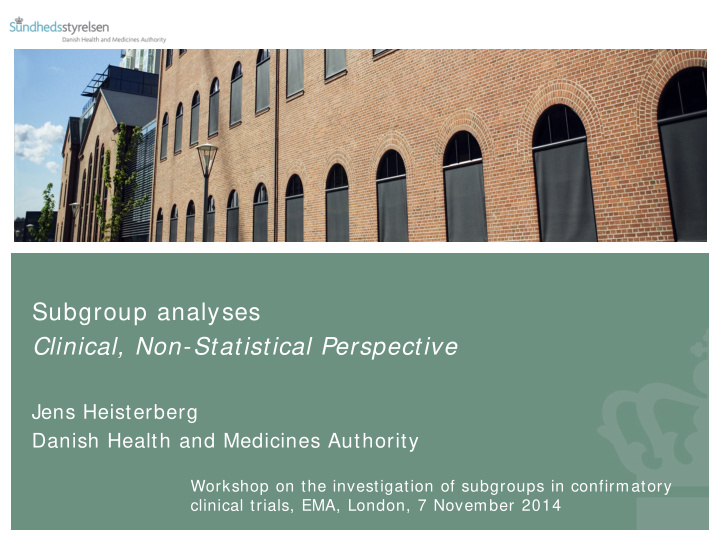



Subgroup analyses Clinical, Non-Statistical Perspective Jens Heisterberg Danish Health and Medicines Authority Workshop on the investigation of subgroups in confirmatory clinical trials, EMA, London, 7 November 2014
2
26 April 2014 Women get medicines tested on men Women often respond completely differently to medicines compared to men – still the posology is based on studies with predominantly men and male mice. It is time for a change, leading researchers argue. (Translated by presenter) 3
Definition Any evaluation of treatment effects for a specific end point in subgroups of patients defined by baseline characteristics. The end point may be a measure of treatment efficacy or safety. R Wang et al. N Engl J Med 2007; 357: 2189-2194 4
Reasons for doing subgroup analyses Honourable reasons Obtain information about patients where it – based on their baseline characteristics – is plausible that the efficacy or safety could be different when compared to the overall population Explore the influence of baseline characteristics – even the ones which would be thought not to influence efficacy and safety of the medicine 5
Reasons for doing subgroup analyses Less honourable reasons Save a failed trial Obtain pseudospecific claims in the label Reach a compromise on a population where the benefit- risk balance could be positive 6
The usual suspects Sex Age Race Geographical region Disease severity Reduced elimination capacity Concomitant medication Previous treatment 7
Biomarkers Increased biological understanding of diseases and the emergence of biomarkers have resulted in an often large number of potential subgroup analyses Improved characterisation of patients Deconstruction of classical clinical entities and definition of new diagnostic criteria and new subcategories Oncology pioneered use of biomarkers in pharmacotherapy 8
Biomarkers Many examples with regulatory impact Oestrogen receptor expression and endocrine therapy: Increased chance of response in breast cancer Trastuzumab and HER2: Increased chance of response in breast cancer Imatinib and Kit (CD 117): Increased chance of response in gastrointestinal stromal tumours Abacavir and HLA-B* 5701: Increased risk of serious hypersensitivity reactions 9
Vectibix (panitumumab) example 10
External validity of pivotal trials Patients in pivotal trials should ideally be representative of patients in the real world Both sexes Elderly patients Patients with common co-morbidities Concomitant medication However, this leads to increased heterogeneity and may further increase the number of subgroups that are relevant to investigate 11
The issue of pre-specification Obviously, it is preferred that subgroup analyses are pre-specified Sometimes regulators ask for additional analyses that were not pre-specified If supported by a sound clinical/ biological rationale, the fact that an analysis was not planned should not by default preclude that the analysis could be used as a basis for licensing a medicine 12
Conclusion Generally, the number of potential subgroup analyses is increasing In pivotal trials, the analyses should be limited to subgroups where it is clinically or biologically plausible that the efficacy or safety of a medicine could be different 13
What do we want from subgroup analyses? Are we merely looking for an indication that the efficacy does not go in the opposite direction and that the safety is not markedly different compared to the overall population? Or do we want a more precise estimate of the efficacy in the subpopulation? How should the subgroup analyses be presented in the product information? 14
Recommend
More recommend